U–Pb Zircon Geochronological and Petrologic Constraints on the Post-Collisional Variscan Volcanism of the Tiddas-Souk Es-Sebt des Aït Ikko Basin (Western Meseta, Morocco)
Abstract
:1. Introduction
2. Geological Background
3. Sampling and Analytical Procedures
3.1. Sampling
3.2. Analytical Procedures
3.2.1. U–Pb Geochronology: Sensitive High-Resolution Ion Microprobe (SHRIMP IIe)
3.2.2. Whole-Rock Geochemistry
3.2.3. Mineral Chemistry: Electron Probe MicroAnalyser (EPMA)
4. Results
4.1. Field Observations and Petrographic Features
4.1.1. Dolerites
4.1.2. Sebt Ait Ikko Andesites
4.1.3. Tiddas Andesites and Associated Pyroclastites
4.1.4. Pyroxenes Dacites
4.1.5. Biotite Rhyolites
4.1.6. Lapilli Tuffs and Rhyolitic Ash Deposits
4.2. Lithostratigraphic Organization
4.3. Mineral Chemistry
4.3.1. Clinopyroxenes of Dacites
4.3.2. Biotite of Rhyolites
4.4. Whole-Rock Geochemistry
4.4.1. Major Elements
- -
- The TiO2, Al2O3, FeO*, MgO, CaO, and P2O5 oxides have a negative correlation with SiO2, while K2O and Na2O have an opposite or a random behavior.
- -
- A negative correlation of Al2O3 and SiO2 in the dacitic terms could be a result of the fractionation of alumino-silicate minerals such as plagioclase. The same correlation is observed in the transition from dacites to rhyolites.
- -
- The occurrence of a hiatus between the mafic terms (andesites), the intermediate and the felsic terms (dacites and rhyolites). The intermediate terms of the felsic andesite type are absent.
4.4.2. Trace Elements
4.5. Geochronology: The Shark Fin Rhyolitic Extrusive Dome of Ari el Mahsar, Sample ARM15
5. Discussion
5.1. The Calc-Alkaline Affinity of TSESDAI Rocks
5.2. Petrogenesis of TSESDAI Rocks
5.2.1. Fractional Crystallization
5.2.2. Crustal Contamination
- (i)
- The absence of basalts and the low volume of andesites compared to dacites and rhyolites. According to [72,73], a thick continental crust would have the effect of prolonging the ascent of basaltic and andesitic flows, and thus the fractional crystallization of minerals at low pressure, therefore favoring differentiation and assimilation until reaching the ultimate rhyodacitic to rhyolitic terms;
- (ii)
- The specific chemical characteristics of the andesites such as the enrichment in highly incompatible elements (Rb, Ba, Th, Sr, K2O, and La) and high ratios (La/Th = 2, 93 to 3; 2.97 on average).
5.3. Volcanological History and Formation Model of the TSESDAI Rocks
5.4. Links between Volcanism and Tectonics in the TSESDAI Basin
5.5. Geochronological Constraints
6. Conclusions
Supplementary Materials
Author Contributions
Funding
Data Availability Statement
Acknowledgments
Conflicts of Interest
References
- Doblas, M.; Oyarzun, R.; López-Ruiz, J.; Cebriá, J.M.; Youbi, N.; Mahecha, V.; Lago, M.; Pocoví, A.; Cabanis, B. Permo-Carboniferous volcanism in Europe and northwest Africa: A superplume exhaust valve in the centre of Pangaea? J. Afr. Earth Sci. 1998, 26, 89–99. [Google Scholar] [CrossRef]
- Wilson, M.; Neumann, E.R.; Davies, G.R.; Timmerman, M.J.; Heeremans, M.; Larsen, B.T. Permo-carboniferous magmatism and rifting in Europe: Introduction. Geol. Soc. Spec. Publ. 2004, 223, 1–10. [Google Scholar] [CrossRef] [Green Version]
- Youbi, N.; Ernst, R.E.; Mitchell, R.N.; Boumehdi, M.A.; El Moume, W.; Lahna, A.A.; Bensalah, M.K.; Söderlund, U.; Doblas, M.; Tassinari, C.C.G. Preliminary Appraisal of a Correlation Between Glaciations and Large Igneous Provinces Over the Past 720 Million Years. In Large Igneous Provinces: A Driver of Global Environmental and Biotic Changes; John Wiley & Sons: Hoboken, NJ, USA, 2021; pp. 169–190. [Google Scholar] [CrossRef]
- Arthaud, F.; Matte, P. Les decrochements tardi-hercyniens du sud-ouest de l’europe. Geometrie et essai de reconstitution des conditions de la deformation. Tectonophysics 1975, 25, 139–171. [Google Scholar] [CrossRef]
- Arthaud, F.; Matte, P. Late Paleozoic strike-slip faulting in southern Europe and northern Africa: Result of a right-lateral shear zone between the Appalachians and the Urals. Bull. Geol. Soc. Am. 1977, 88, 1305–1320. [Google Scholar] [CrossRef]
- Cailleux, Y.; Gonord, H.; Le guern, M.; Sauvage, M. Taphrogenèse et magmatisme permien dans le Maroc Central. Bull. Fac. Sci. Marrakech. 1983, 1, 24–39. [Google Scholar]
- Youbi, N.; Cabanis, B.; Chalot-Prat, F.; Cailleux, Y. Histoire volcano-tectonique du massif permien de Khénifra (Sud-Est du Maroc central). Geodin. Acta 1995, 8, 158–172. [Google Scholar] [CrossRef]
- Van Hilten, D. Evaluation of some geotectonic hypotheses by paleomagnetism. Tectonophysics 1964, 1, 3–71. [Google Scholar] [CrossRef]
- Elter, F.M.; Gaggero, L.; Mantovani, F.; Pandeli, E.; Costamagna, L.G. The Atlas-East Variscan -Elbe shear system and its role in the formation of the pull-apart Late Palaeozoic basins. Int. J. Earth Sci. 2020, 109, 739–760. [Google Scholar] [CrossRef]
- Timmerman, M.J.; Heeremans, M.; Kirstein, L.A.; Larsen, B.T.; Spencer-Dunworth, E.A.; Sundvoll, B. Linking changes in tectonic style with magmatism in northern Europe during the late Carboniferous to latest Permian. Tectonophysics 2009, 473, 375–390. [Google Scholar] [CrossRef] [Green Version]
- Upton, B.G.J.; Stephenson, D.; Smedley, P.M.; Wallis, S.M.; Fitton, J.G. Carboniferous and Permian magmatism in Scotland. Geol. Soc. Spec. Publ. 2004, 223, 195–218. [Google Scholar] [CrossRef] [Green Version]
- Ernst, R.E.; Buchan, K.L. Layered mafic intrusions: A model for their feeder systems and relationship with giant dyke swarms and mantle plume centres. S. Afr. J. Geol. 1997, 100, 319–334. [Google Scholar]
- Torsvik, T.H.; Steinberger, B.; Cocks, L.R.M.; Burke, K. Longitude: Linking Earth’s ancient surface to its deep interior. Earth Planet. Sci. Lett. 2008, 276, 273–282. [Google Scholar] [CrossRef]
- Kirstein, L.A.; Dunai, T.J.; Davies, G.R.; Upton, B.G.J.; Nikogosian, I.K. Helium isotope signature of lithospheric mantle xenoliths from the Permo-Carboniferous magmatic province in Scotland—No evidence for a lower-mantle plume. Geol. Soc. Spec. Publ. 2004, 223, 243–258. [Google Scholar] [CrossRef]
- Veevers, J.J.; Powell, C.M. Late Paleozoic glacial episodes in Gondwanaland reflected in transgressive- regressive depositional sequences in Euramerica. Geol. Soc. Am. Bull. 1987, 98, 475–487. [Google Scholar] [CrossRef]
- Crowell, J.C. Pre-Mesozoic Ice Ages: Their Bearing on Understanding the Climate System; Geological Society of America, Inc.: Boulder, CO, USA, 1999; Volume 192, ISBN 0813711924. [Google Scholar]
- Isbell, J.L.; Miller, M.F.; Wolfe, K.L.; Lenaker, P.A. Timing of Late Paleozoic Glaciation in Gondwana: Was Glaciation Responsible for the Development of Northern Hemisphere Cyclothems? Special Paper of The Geological Society of America; Geological Society of America, Inc.: Boulder, CO, USA, 2003; Volume 370. [Google Scholar] [CrossRef]
- Cather, S.M.; Dunbar, N.W.; McDowell, F.W.; McIntosh, W.C.; Scholle, P.A. Climate forcing by iron fertilization from repeated ignimbrite eruptions: The icehouse-silicic large igneous province (SLIP) hypothesis. Geosphere 2009, 5, 315–324. [Google Scholar] [CrossRef] [Green Version]
- El Wartiti, M.; Broutin, J.; Freytet, P.; Larhrib, M.; Toutin-Morin, N. Continental deposits in Permian basins of the Mesetian Morocco, geodynamic history. J. Afr. Earth Sci. 1990, 10, 361–368. [Google Scholar] [CrossRef]
- Saber, H.; El-Wartiti, M.; Broutin, J.; Toutin Morin, N. L’intervalle stephano-permien (fin du cycle varisque au Maroc). Gaia 1995, 11, 57–71. [Google Scholar]
- Saber, H.; El Wartiti, M. Histoire sédimentaire et tectonique tardi-hercynienne des bassins de l’Oued Zat et Ida Ou Zal (Haut Atlas occidental, Maroc): Bassins en transtension sur décrochements. J. Afr. Earth Sci. 1996, 22, 301–309. [Google Scholar] [CrossRef]
- Abbou, M.B.; Soula, J.C.; Brusset, S.; Roddaz, M.; N’Tarmouchant, A.; Driouch, Y.; Christophoul, F.; Bouadbelli, M.; Majesté-Menjoulas, C.; Béziat, D.; et al. Contrôle tectonique de la sédimentation dans le système de bassins d’avant-pays de la Meseta marocaine. C. R. Acad. Sci. Ser. IIA Earth Planet. Sci. 2001, 5, 703–709. [Google Scholar] [CrossRef]
- Domeier, M.; Font, E.; Youbi, N.; Davies, J.; Nemkin, S.; Van der Voo, R.; Perrot, M.; Benabbou, M.; Boumehdi, M.A.; Torsvik, T.H. On the Early Permian shape of Pangea from paleomagnetism at its core. Gondwana Res. 2021, 90, 171–198. [Google Scholar] [CrossRef]
- Hoepffner, C.; Soulaimani, A.; Piqué, A. The Moroccan Hercynides. J. Afr. Earth Sci. 2005, 43, 144–165. [Google Scholar] [CrossRef]
- Michard, A.; Soulaimani, A.; Hoepffner, C.; Ouanaimi, H.; Baidder, L.; Rjimati, E.C.; Saddiqi, O. Tectonophysics The South-Western Branch of the Variscan Belt: Evidence from Morocco. Tectonophysics 2010, 492, 1–24. [Google Scholar] [CrossRef]
- Michard, A.; Ouanaimi, H.; Hoepffner, C.; Soulaimani, A.; Baidder, L. Comment on Tectonic relationships of Southwest Iberia with the allochthons of Northwest Iberia and the Moroccan Variscides by J.F. Simancas et al. [C. R. Geoscience 341 (2009) 103–113]. C. R. Geosci. 2010, 342, 170–174. [Google Scholar] [CrossRef]
- Gonord, H.; Le Guern, M.; Turiot, D.; Rebourd, H. Mise en évidence d’un volcanisme rhyolitique stéphano-permien sur la bordure nord du massif hercynien central du Maroc extension et importance du volcanisme tardy-hercynien. C. R. Acad. Sci. 1980, 291, 51–54. [Google Scholar]
- El Wartiti, M. Les Terrains Permo-Carbonifères et Leur Couverture dans la Zone de Tiddas-Souk es Sebt (Bordure Nord-Ouest de la Méséta Marocaine. Nord du Maroc Central). Ph.D. Thesis, Mohamed V, Rabat, Morocco, 1981. [Google Scholar]
- Zouine, E.M. Evolution structurale tardi-hercynienne de la bordure septentrionale du Maroc Central entre Tiddas et Jbel Triona. Ph.D. Thesis, E.N.S. Souissi, Rabat, Morocco, 1986. [Google Scholar]
- Larhrib, M. Les Formations Permiennes et Triasico-Mio-Quaternaires des Régions de Tiddas, Maaziz et Sebt Aït Ikko (NW du Maroc Central). Stratigraphie, Sédimentologie et Reconstitution des Paléoenvironnements Sédimentaires. Ph.D. Thesis, Ecole Normale Supérieure, Rabat, Morocco, 1988. [Google Scholar]
- Larhrib, M. Les formations fluviatiles rouges violacées du bassin permien (Autunien inférieur) de Tiddas-Sebt Aït Ikkou (NW du Maroc Central). In Proceedings of the 8ème Colloque Bassins Sédimentaires, El Jadida, Morocco, 23–25 May 1990; pp. 3–4. [Google Scholar]
- Larhrib, M. Flore fossile et séquences des formations rouges fluviatiles du bassin autunien de Tiddas-Sebt Aït Ikkou (nord-ouest du Maroc central). In Le Permien et le Trias du Maroc: État des Connaissances; Medina, F., Ed.; Presses Universitaires du Maghreb: Marrakech, Morocco, 1996; pp. 19–29. [Google Scholar]
- Voigt, S.; Lagnaoui, A.; Hminna, A.; Saber, H.; Schneider, J.W. Revisional notes on the Permian tetrapod ichnofauna from the Tiddas Basin, central Morocco. Palaeogeogr. Palaeoclimatol. Palaeoecol. 2011, 302, 474–483. [Google Scholar] [CrossRef]
- Broutin, J.; Aassoumi, H.; El Wartiti, M.; Freytet, P.; Kerp, H.; Quesada, C.; Toutin-morin, N. The Permian basins of Tiddas, Bou Achouch and Khenifra (central Morocco). Biostratigraphic and palaeophytogeographic implications. Mémoires Muséum Natl. d’Histoire Nat. 1998, 179, 257–278. [Google Scholar]
- Marchetti, L.; Ronchi, A.; Santi, G.; Schirolli, P.; Conti, M.A. Revision of a classic site for Permian tetrapod ichnology (Collio Formation, Trompia and Caffaro valleys, N. Italy), new evidences for the radiation of captorhinomorph footprints. Palaeogeogr. Palaeoclimatol. Palaeoecol. 2015, 433, 140–155. [Google Scholar] [CrossRef]
- Termier, H. Etudes géologiques sur le Maroc Central et le Moyen Atlas septentrional, Rabat. 1936. Available online: https://www.persee.fr/doc/rga_0035-1121_1937_num_25_3_3982_t1_0525_0000_1 (accessed on 20 May 2021).
- Michard, A. Elements de Geologie Marocaine; Notes et Memoires du Service Geologique No. 252; Editions du Service Geologique du Maroc: Rabat, Morroco, 1976; p. 408. [Google Scholar]
- Youbi, N. Le Volcanisme “Post-Collisionnel” un Magmatisme Intraplaque Relié à des Panaches Mantelliques. Etude Volcanologique et Géochimique. Exemple d’application dans le Néoprotérozoique Terminal (PIII) de l’Anti-Atlas et le Permien du Maroc. Ph.D. Thesis, Faculty SEMLALIA, CAdi AYYAD, Marrakesh, Morocco, 1998. [Google Scholar]
- Black, L.P.; Kamo, S.L.; Allen, C.M.; Davis, D.W.; Aleinikoff, J.N.; Valley, J.W.; Mundil, R.; Campbell, I.H.; Korsch, R.J.; Williams, I.S.; et al. Improved 206Pb/238U microprobe geochronology by the monitoring of a trace-element-related matrix effect; SHRIMP, ID-TIMS, ELA-ICP-MS and oxygen isotope documentation for a series of zircon standards. Chem. Geol. 2004, 205, 115–140. [Google Scholar] [CrossRef]
- Williams, I.S. U-Th-Pb geochronology by ion microprobe. In Applications of Microanalytical Techniques to Understanding Mineralising Processes; McKibben, M., Shanks, W., Riley, W., Eds.; Reviews in Economic Geology; Society of Economic Geologists: Littleton, CO, USA, 1998; pp. 1–35. [Google Scholar]
- Ludwig, K.R. Isoplot 3: A Geochronological Toolkit for Microsoft Excel. Berkeley Geochronol. Cent. 2003, 4, 70. [Google Scholar]
- Ouabid, M.; Garrido, C.J.; Ouali, H.; Harvey, J.; Hidas, K.; Marchesi, C.; Acosta-Vigil, A.; Dautria, J.M.; El Messbahi, H.; Román-Alpiste, M.J. Late Cadomian rifting of the NW Gondwana margin and the reworking of Precambrian crust–evidence from bimodal magmatism in the early Paleozoic Moroccan Meseta. Int. Geol. Rev. 2020, 1–24. [Google Scholar] [CrossRef]
- Morimoto, N. Nomenclature of Pyroxenes. Mineral. Petrol. 1988, 39, 55–76. [Google Scholar] [CrossRef]
- Tiba, T. Titaniferous Biotites and Associated Phenocrysts in Dike Rocks From Dozen, Oki Islands. J. Jpn. Assoc. Mineral. Petrol. Econ. Geol. 1972, 67, 357–369. [Google Scholar] [CrossRef]
- Le Bel, L. Micas magmatiques et hydrothermaux dans l’environnement du porphyre cuprifère de Cerro Verde-Santa Rosa, Pérou. Bull. Minéral. 1979, 102, 35–41. [Google Scholar] [CrossRef]
- Nachit, H.; Razafimahefa, N.; Stussi, J.; Carron, J. Composition chimique des biotites et typologie magmatique des granitoïdes. C. R. Acad. Sci. 1985, 301, 813–818. [Google Scholar]
- Abdel-Rahman, A.F.M. Nature of biotites from alkaline, calc-alkaline, and peraluminous magmas. J. Petrol. 1994, 35, 525–541. [Google Scholar] [CrossRef]
- Deer, W.; Howie, R.A.; Zussman, J. An Introduction to Rock-Forming Minerals; Mineralogical Society of Great Britain & Ireland: London, UK, 1966. [Google Scholar]
- Bas, M.J.L.; Maitre, R.W.L.; Streckeisen, A.; Zanettin, B. A chemical classification of volcanic rocks based on the total alkali-silica diagram. J. Petrol. 1986, 27, 745–750. [Google Scholar] [CrossRef]
- Miyashiro, A. Nature of alkalic volcanic rock series. Contrib. Mineral. Petrol. 1978, 66, 91–104. [Google Scholar] [CrossRef]
- Harker, A. Igneous rock-series and mixed igneous rocks. J. Geol. 1900, 8, 389–399. [Google Scholar] [CrossRef]
- Saunders, A.; Tarney, J.; Marsh, N.; Wood, D. Ophiolites as oceanic crust or marginal basin crust: A geochemical approach. In Proceedings of the Ophiolites International Ophiolite Symposium, Nicosia, Chyprus, 1–8 April 1979; pp. 193–204. [Google Scholar]
- Cabanis, B. Identification des Séries Magmatiques dans les Socles Métamorphiques sur la Base de Critères Géologiques, Pétrographiques et Géochimiques. Ph.D. Thesis, P. et M.-Curie, Paris, France, 1986. [Google Scholar]
- Thorpe, R.S.; Leat, P.T.; Mann, A.C.; Howells, M.F.; Reedman, A.J.; Campbell, S.D.G. Magmatic evolution of the ordovician snowdon volcanic centre, North Wales (UK). J. Petrol. 1993, 34, 711–741. [Google Scholar] [CrossRef]
- Harris, N.B.W.; Pearce, J.A.; Tindle, A.G. Geochemical Characteristics of Collision-Zone Magmatism; Special Publications; Geological Society: London, UK, 1986; Volume 19, pp. 67–81. [Google Scholar] [CrossRef]
- Pupin, J.P. Zircon and granite petrology. Contrib. Mineral. Petrol. 1980, 73, 207–220. [Google Scholar] [CrossRef]
- Hoskin, P.W.O.; Schaltegger, U. The composition of zircon and igneous and metamorphic petrogenesis. Rev. Mineral. Geochem. 2003, 53, 27–62. [Google Scholar] [CrossRef]
- Linnemann, U.; Gerdes, A.; Drost, K.; Buschmann, B. The continuum between Cadomian orogenesis and opening of the Rheic Ocean: Constraints from LA-ICP-MS U-Pb zircon dating and analysis of plate-tectonic setting (Saxo-Thuringian zone, northeastern Bohemian Massif, Germany). Spec. Pap. Geol. Soc. Am. 2007, 423, 61–96. [Google Scholar] [CrossRef] [Green Version]
- Winchester, J.A.; Floyd, P.A. Geochemical discrimination of different magma series and their differentiation products using immobile elements. Chem. Geol. 1977, 20, 325–343. [Google Scholar] [CrossRef] [Green Version]
- Pearce, J.A. Geochemical fingerprinting of oceanic basalts with applications to ophiolite classification and the search for Archean oceanic crust. Lithos 2008, 100, 14–48. [Google Scholar] [CrossRef]
- Miyashiro, A. The troodos ophiolitic complex was probably formed in an island arc. Earth Planet. Sci. Lett 1973, 19, 218–224. [Google Scholar] [CrossRef]
- Miyashiro, A. Volcanic rock series in island arcs and active continental margins. Am. J. Sci. 1974, 274, 321–355. [Google Scholar] [CrossRef]
- Leterrier, J.; Maury, R.C.; Thonon, P.; Girard, D.; Marchal, M. Clinopyroxene composition as a method of identification of the magmatic affinities of paleo-volcanic series. Earth Planet. Sci. Lett. 1982, 59, 139–154. [Google Scholar] [CrossRef]
- Mollard, J.; Maury, R.C.; Leterrier, J.; Bourgois, J. Teneurs en chrome et titane des clinopyroxenes calciques des basaltes; Application à l’identification des affinités magmatiques de roches paléovolcaniques. C. R. Acad. Sci. 1983, 296, 903–908. [Google Scholar]
- Sheth, H.C.; Torres-Alvarado, I.S.; Verma, S.P. What is the “calc-alkaline rock series”? Int. Geol. Rev. 2002, 44, 686–701. [Google Scholar] [CrossRef]
- Hawkesworth, C.; Turner, S.; Gallagher, K.; Hunter, A.; Bradshaw, T.; Rogers, N. Calc-alkaline magmatism, lithospheric thinning and extension in the Basin and Range. J. Geophys. Res. 1995, 100, 10271–10286. [Google Scholar] [CrossRef]
- Fan, W.M.; Guo, F.; Wang, Y.J.; Lin, G. Late Mesozoic calc-alkaline volcanism of post-orogenic extension in the northern Da Hinggan Mountains, northeastern China. J. Volcanol. Geotherm. Res. 2003, 121, 115–135. [Google Scholar] [CrossRef]
- Dupuy, C.; Dostal, J.; Marcelot, G.; Bougault, H.; Joron, J.L.; Treuil, M. Geochemistry of basalts from central and southern New Hebrides arc: Implication for their source rock composition. Earth Planet. Sci. Lett. 1982, 60, 207–225. [Google Scholar] [CrossRef]
- Deruelle, B. Petrology of the plio-quaternary volcanism of the South-Central and Meridional Andes. J. Volcanol. Geotherm. Res. 1982, 14, 77–124. [Google Scholar] [CrossRef]
- Gans, P.B.; Mahood, G.A.; Schermer, E. Synextensional magmatism in the Basin and Range Province; A case study from the eastern Great Basin. Spec. Pap. Geol. Soc. Am. 1989, 233, 1–53. [Google Scholar] [CrossRef]
- Putirka, K.; Platt, B. Basin and Range volcanism as a passive response to extensional tectonics. Geosphere 2012, 8, 1274–1285. [Google Scholar] [CrossRef] [Green Version]
- Gill, J. Orogenic Andesites and Plate Tectonics; Springer: Berlin/Heidelberg, Germany, 1981. [Google Scholar]
- Coulon, C. Le volcanisme calco-alcalin cénozoïque de Sardaigne (Italie). Pétrographie, géochimie et génèse des laves andésitiques et des ignimbrites. Signification géodynamique. Ph.D. Thesis, AIX-MARSEILLE III, Marseille, France.
- DePaolo, D.J. Trace element and isotopic effects of combined wallrock assimilation and fractional crystallization. Earth Planet. Sci. Lett. 1981, 53, 189–202. [Google Scholar] [CrossRef]
- Emami, M.H.; Michel, R. Les Volcans Dôméens du Néogène de la Région de Qom (Iran Central). Essai de Classification de l’Activité Volcanique Dôméenne. Bull. Volcanol. 1982, 45, 317–332. [Google Scholar] [CrossRef]
- Kharbouch, F. Pétrographie et Géochimie des Laves Dinantiennes de la Méséta Nord-Occidentale et Orientale Marocaine. Ph.D. Thesis, Louis Pasteur, Strasbourg, France, 1983. [Google Scholar]
- Kharbouch, F. Le volcanisme dévono-dinantien du Massif central et de la Meseta orientale. Bull. Inst. Sci. 1994, 18, 192–200. [Google Scholar]
- Chalot-Prat, F. Mise en évidence d’une dépression volcanotectonique associée à d’épais épanchements ignimbritiques hercyniens dans le massif du Tazekka (Maroc oriental). Rev. Géologie Dyn. Géographie Phys. 1986, 27, 193–203. [Google Scholar]
- Chalot-Prat, F. Pétrogénèse d’un Volcanisme Intracontinental Tardi-Orogénique Hercynien. Etude du Complexe Volcanique Carbonifère du Tazekka et de Zones Volcaniques Comparables dans le Mekam et la Région de Jerada (Maroc Oriental). Ph.D. Thesis, P. et M. Curie, Paris, France, 1990. [Google Scholar]
- Chakib, A.; Aït Brahim, L.; Tahiri, A. Tectonique cassante et paléochamps de contraintes dans les régions de Bou Chahraine, d’el Jemaa Moud Bled et Merzaga du Permien à l’actuel (bordure méridionale du bassin de Rommani-Khémisset). In Proceedings of the 13 éme Colloque des Bassins Sédimentaires Marocains, Marrakech, Morocco, 19–22 March 1996; pp. 69–70. [Google Scholar]
- Aït Brahim, L.; Tahiri, A.; Saidi, A. Proposition d’une nouvelle chronologie des événements tectoniques responsables de la structuration du bassin sur décrochement permien de Bou-Achouch (bordure septentrionale de la Meseta central). In Proceedings of the 13 éme Colloque des Bassins Sédimentaires Marocains, Marrakech, Morocco, 19–22 March 1996; pp. 9–10. [Google Scholar]
- Hmich, D.; Schneider, J.W.; Saber, H.; Voigt, S.; El Wartiti, M. New continental Carboniferous and Permian faunas of Morocco: Implications for biostratigraphy, palaeobiogeography and palaeoclimate. Geol. Soc. Spec. Publ. 2006, 265, 297–324. [Google Scholar] [CrossRef]
- Kerp, H.; Broutin, J.; Lausberg, S.; Aassoumi, H. Discovery of Latest Carboniferous–Early Permian radially symmetrical peltaspermaceous megasporophylls from Europe and North Africa. C. R. Acad. Sci. Ser. IIA Earth Planet. Sci. 2001, 332, 513–519. [Google Scholar] [CrossRef]
- Jébrak, M. Contribution à l’histoire Naturelle des Filons (F, Ba) du Domaine Varisque Français et Marocain. Essai de Caractérisation Structurale et Géochimique des Filons en Extension et en Décrochement. Ph.D. Thesis, Univiversity of Orleans, Orleans, France, 1984. [Google Scholar]
- Aassoumi, H.; Broutin, J.; Youbi, N. Découverte de Scleromedulloxylon cf. aveyronense, bois fossile de coniférophyte, dans le complexe volcanique permien du bassin de Khnifra (Maroc): Intérêt stratigraphique et floristique. Ann. Paléontol. 1995, 81, 1–16. [Google Scholar]
- Youbi, N. Le complexe volcanique permien de Khenifra (SE du Maroc central): Cartographie, volcanologie, minéralogie, géochimie, considérations structurales et implications géodynamiques. Ph.D. Thesis, Cadi Ayyad University, Marrakesh, Morocco, 1990. [Google Scholar]
- Youbi, N.; Gaggero, L.; Assafar, H.; Hadimi, I.; Boumehdi, M.A.; Bensalah, M.K.; Linnemann, U.; Gaertner, A.; Mata, J.; Doblas, M.; et al. U-Pb Zircon Geochronological and Petrologic Constraints on the PostCollisional Variscan Volcanism of the Khénifra Basin (Western Meseta, Morocco): Stratigraphic and Petrogenetic Implications. In Proceedings of the 2nd International Congress on Permian and Triassic, Casablanca, Morocco, 25–27 April 2018; pp. 53–54. [Google Scholar]
- Van Houten, F. Late Variscan Nonmarine Basin Deposits, Northwest Africa: Record of Hercynotype Orogeny. In The Continental Permain in Central, West, and South Europe; Springer: Dordrecht, The Netherlands, 1976; pp. 215–224. [Google Scholar]
- Hadimi, I.; Ait Lahna, A.; Assafar, H.; Tassinari, C.C.G.; Youbi, N.; Boumehdi, M.; Bensalah, M.K.; Gaggero, L.; Mata, J.; Doblas, M. The Post-Collisional Hercynian Volcanism of Rehamna, Western Meseta, Morocco. Mineral Chemistry, Petrology and U-Pb Dating. In Proceedings of the 2nd International Congress on Permian and Triassic, Casablanca, Morocco, 25–27 April 2018; pp. 33–35. [Google Scholar]
- Baudin, T.; Chèvremont, P.; Razin, P.; Youbi, N.; Andries, D.; Hoepffner, C.; Tegyey, M. Carte géologique du Maroc au 1/50000, feuille de Skhour des Rehamna, Mémoire explicatif. Notes Mém. Serv. Géol. Maroc 2003, 435, 114. [Google Scholar]
- Bensalah, M.K. De la fin du cycle orogénique hercynien à l’ouverture et l’évolution de l’Atlantique Central: Les marqueurs magmatiques de cette transition. Etude pétrologique et géochimique. Exemple d’application dans le Permien, le TriasJurassique et le Jurassique-Cré. Ph.D. Thesis, CAADi AYYAD, Marrakesh, Morocco, 2012. [Google Scholar]
- Bensalah, M.K.; Youbi, N.; Ait Lahna, A.; Tassinari, C.C.G.; Boumehdi, M.A.; Basei, M.A.S.; Sato, K.; Aarab, E.M.; Mata, J. Geochemical and Geochronological Constraints on the Origin of the Intermediate and Felsic Dyke and Sill Swarms from the Western Meseta and the High Atlas (Morocco): Implications for Tectonic Evolution. In Proceedings of the 2nd International Congress on Permian and Triassic, Casablanca, Morocco, 25–27 April 2018; pp. 20–22. [Google Scholar]
- Hoepffner, C. Le magmatisme pré- et post-orogénique hercynien dans le Paléozoïque des Rehamna. Serv. Géologique du Maroc Rabat 1982, 303, 150–163. [Google Scholar]
- Charif, A. Etude Pétrographique et Géochimique du Volcanisme ”Post-Collisionnel” du Permien Inférieur (Autunien) des Rahamna (Mechraâ Ben Abbou et Nazt Lararcha, Messta-Maroc): Implications Géochimiques, Pétrogénétiques et Géodynamiques. Ph.D. Thesis, University of Chouaib Doukkali, El Jadida, Morocco, 2001. [Google Scholar]
- Razin, P.; Baudin, T.; Chèvremont, P.; Andries, D.; Youbi, N.; Hœpffner, C.; Thiéblemont, D.; Chihani, E. Carte géologique du Maroc au 1/50 000, feuille de Jebel Kharrou, Mémoire explicatif. Notes Mém. Serv. Géol. Rabat 2003, 436, 1–105. [Google Scholar]
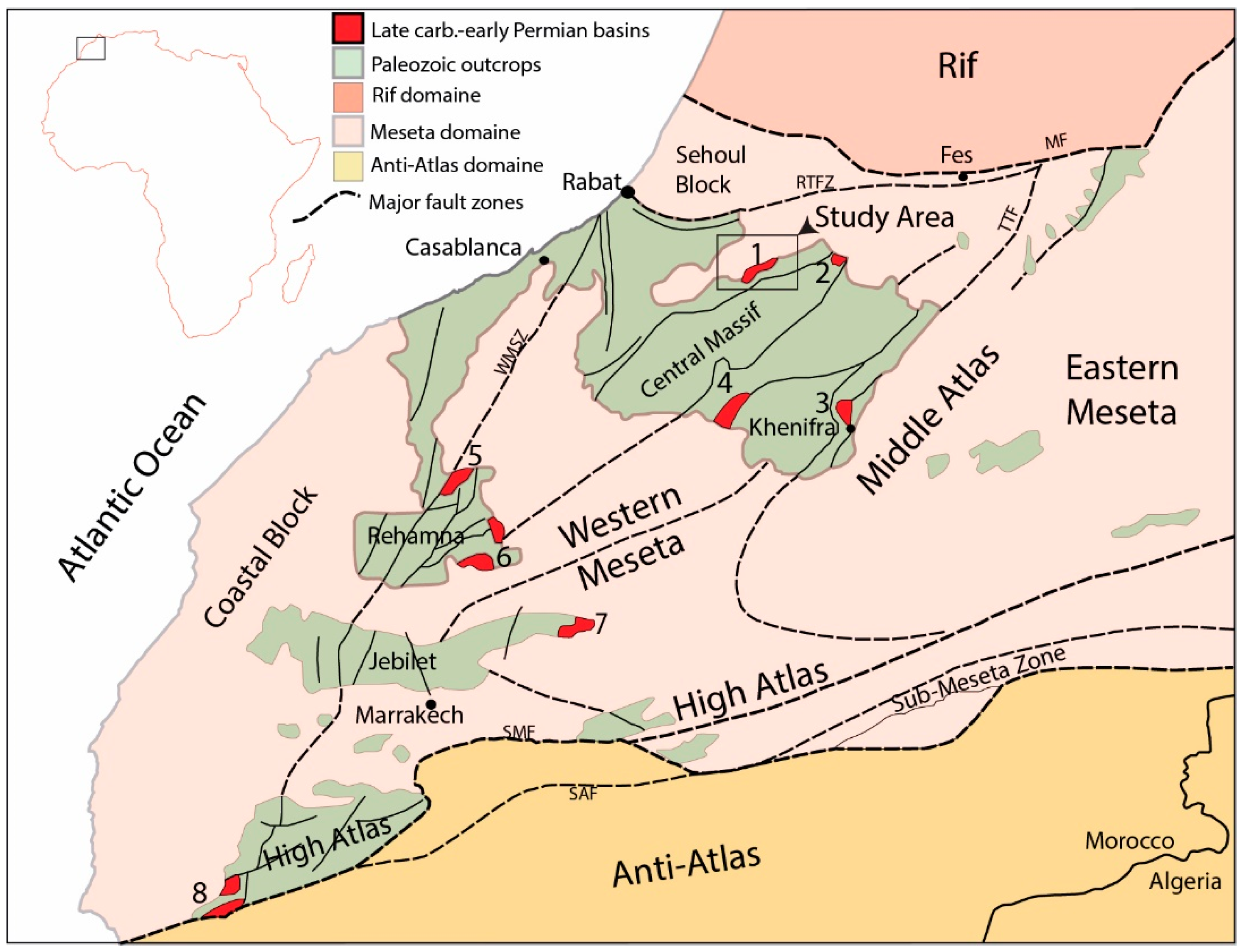
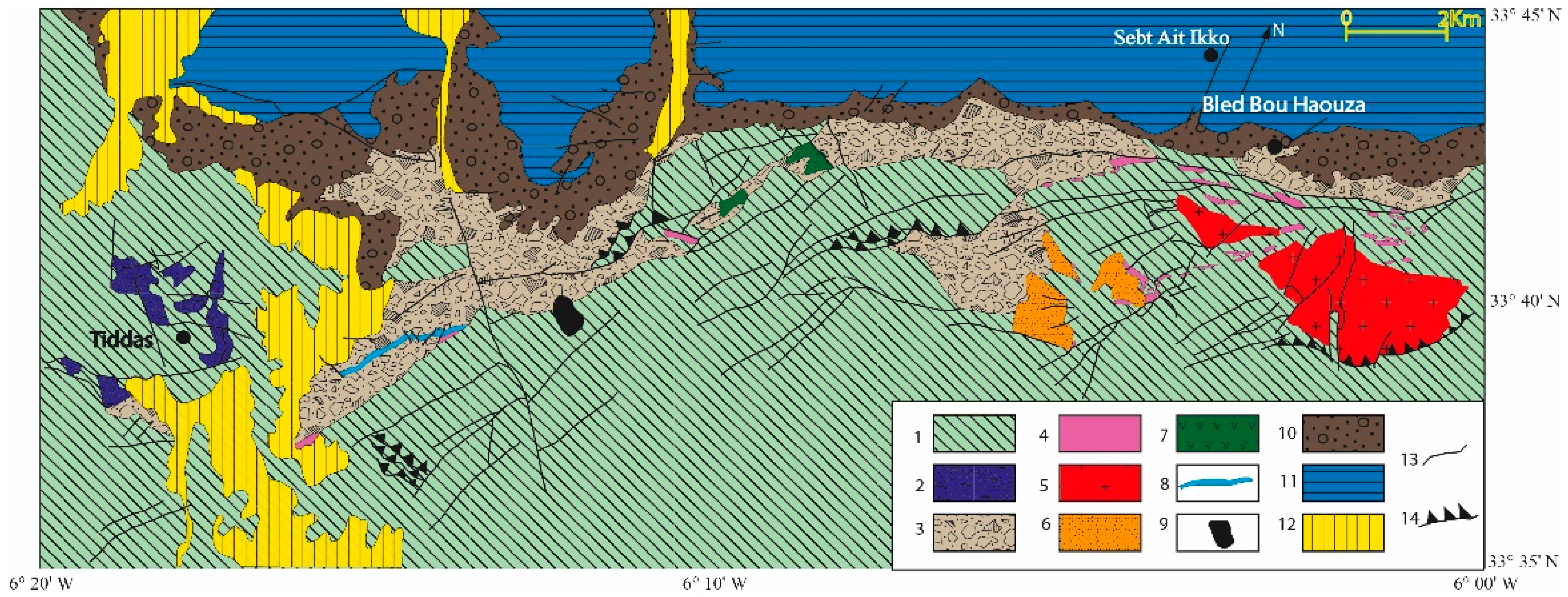
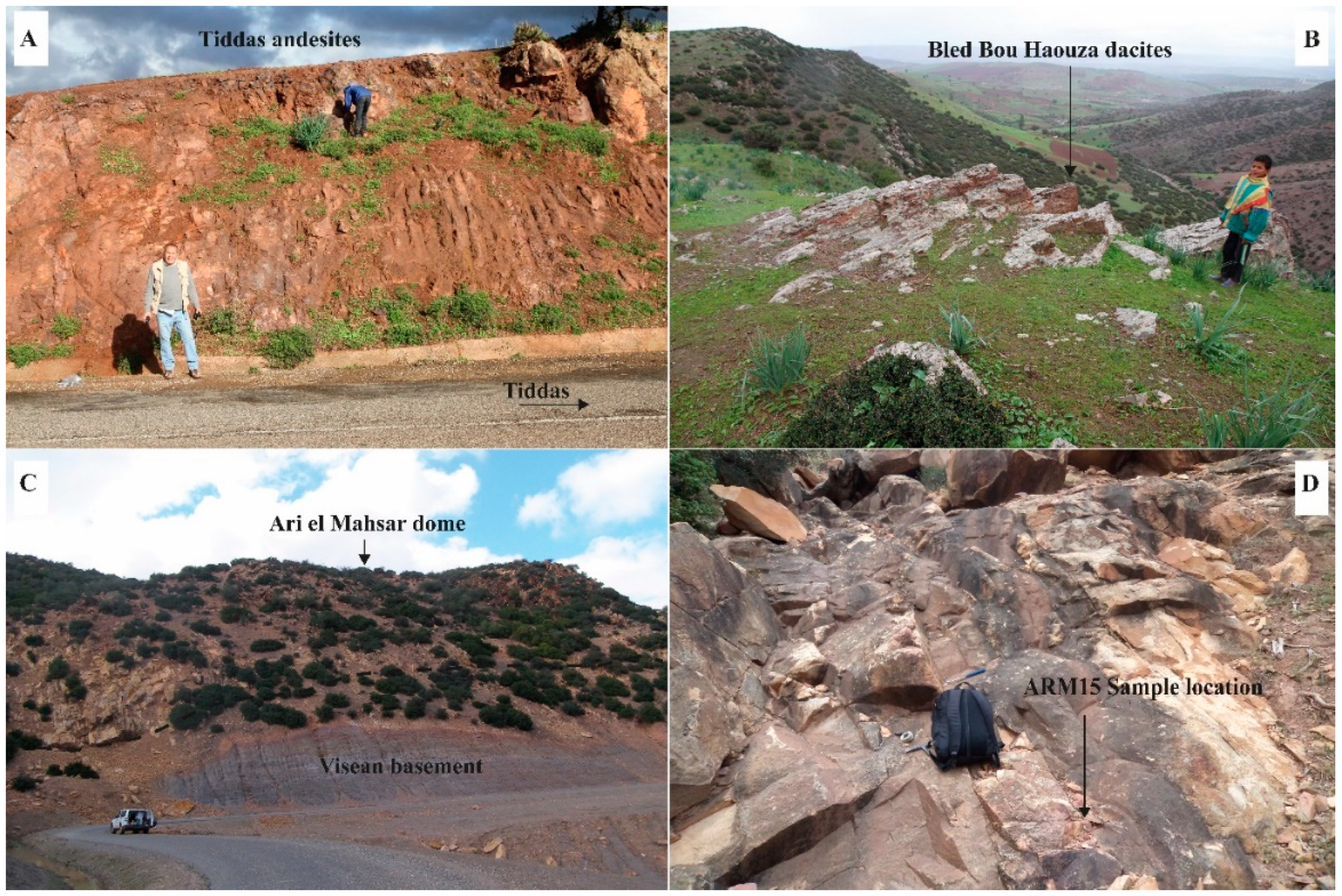

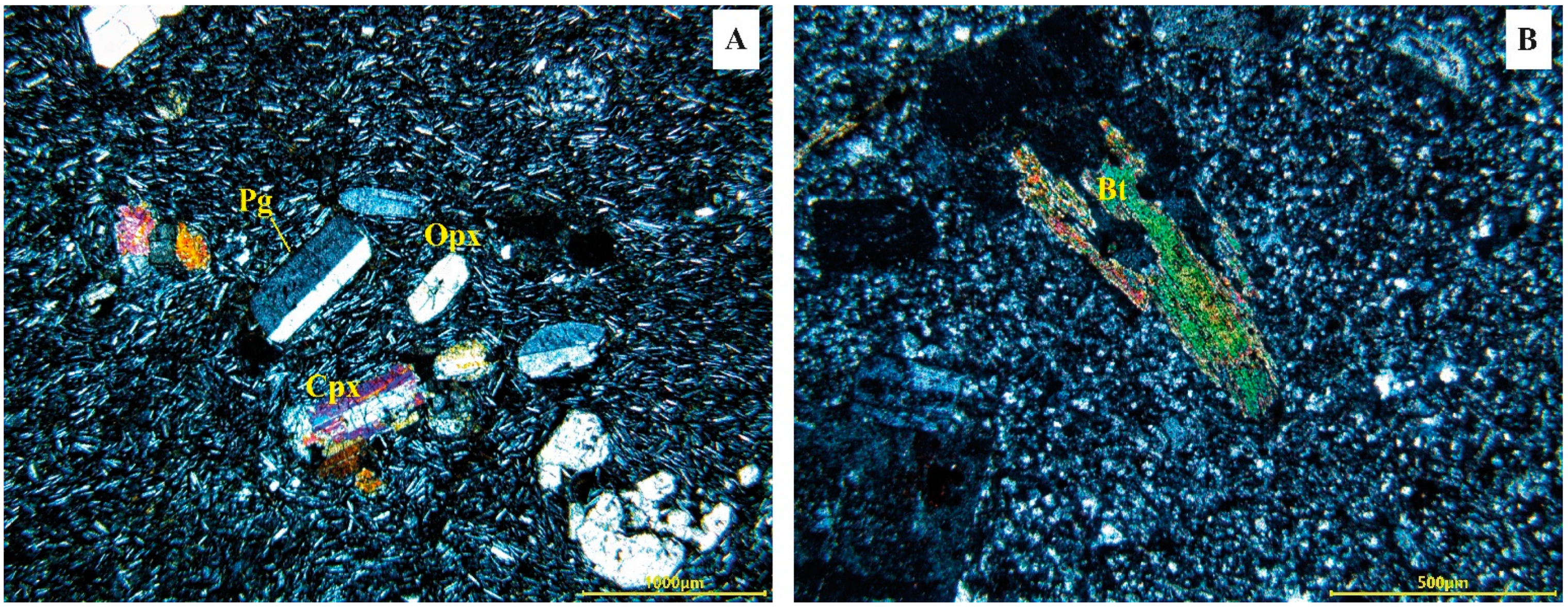
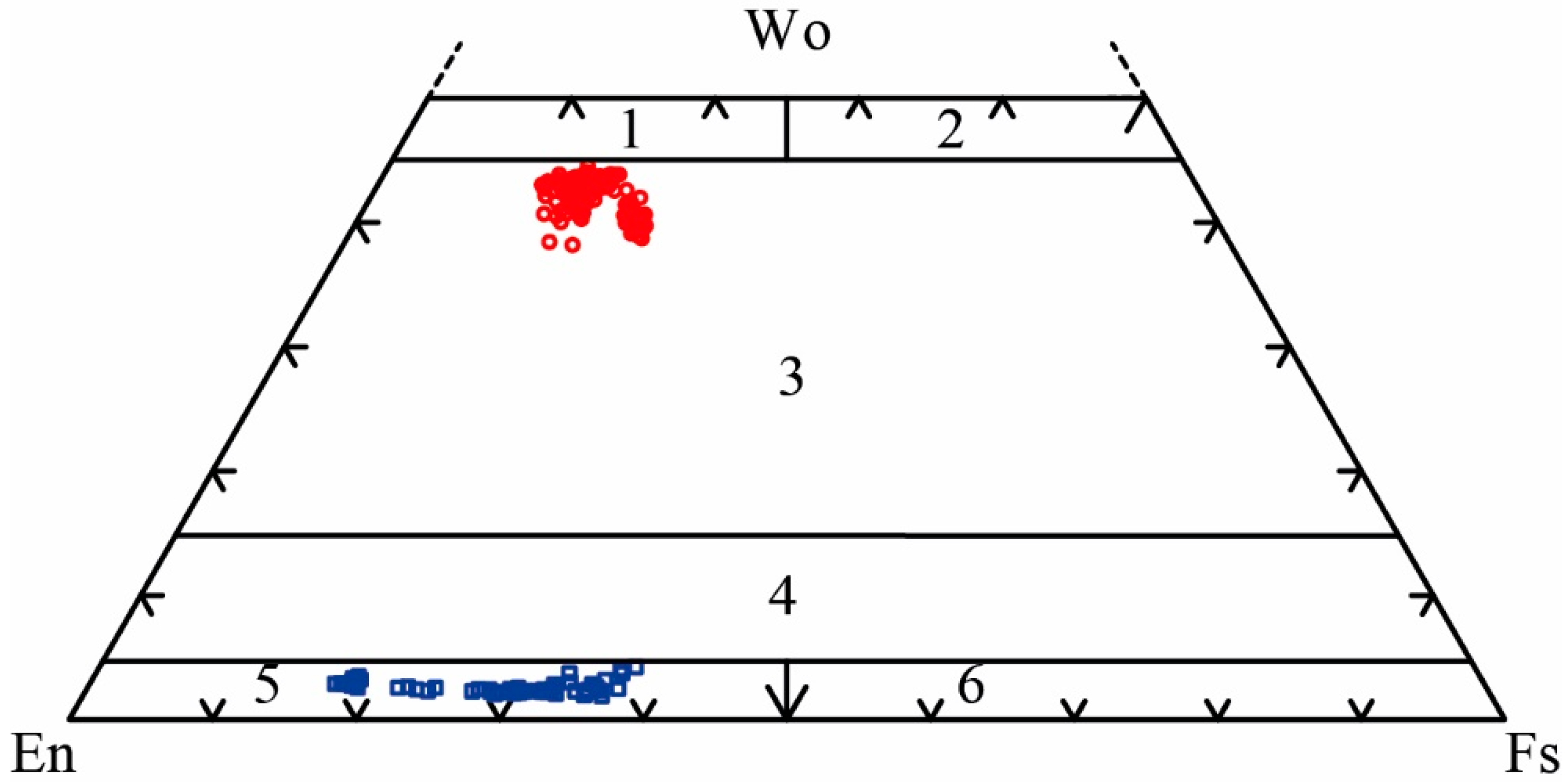
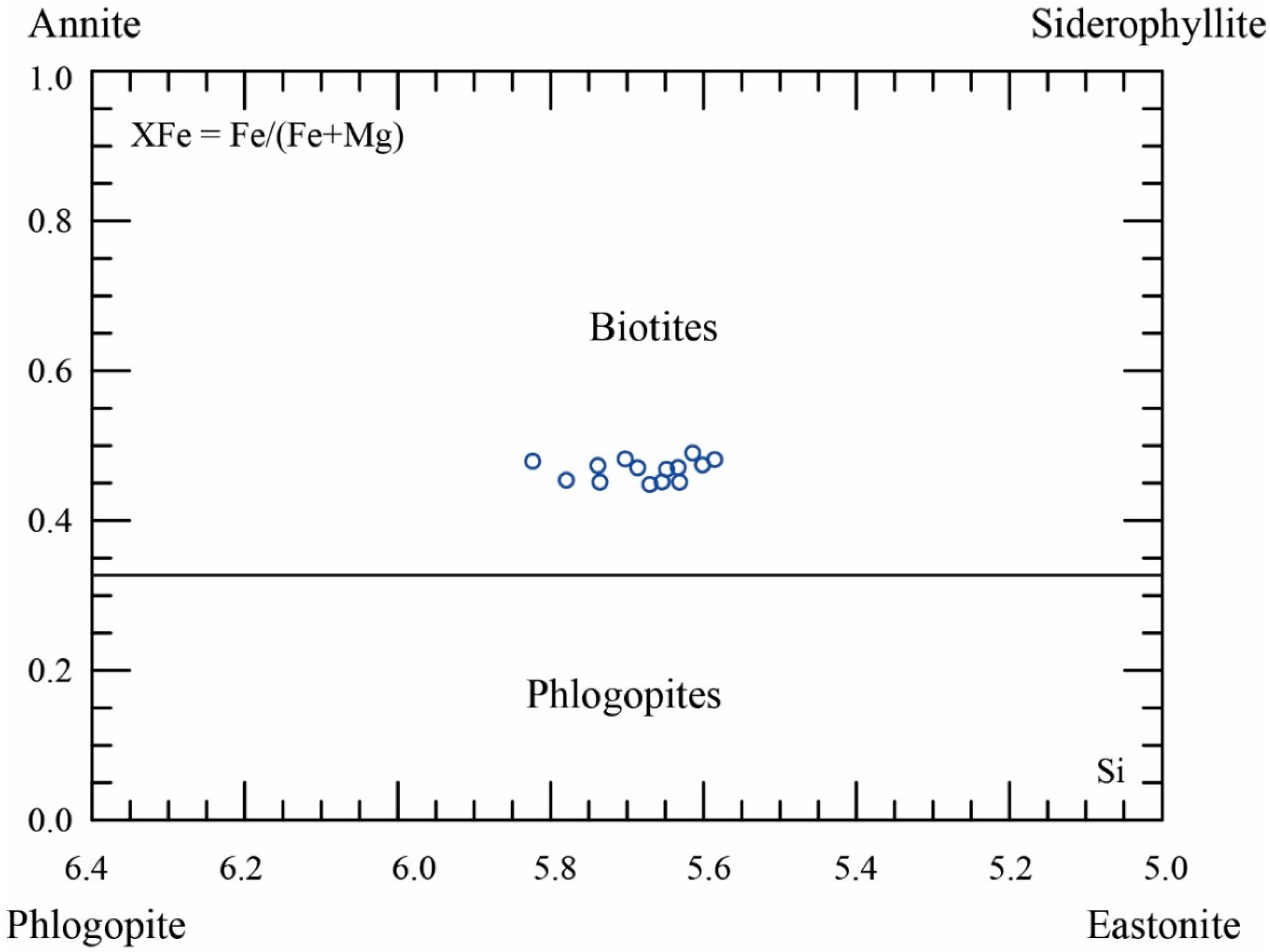
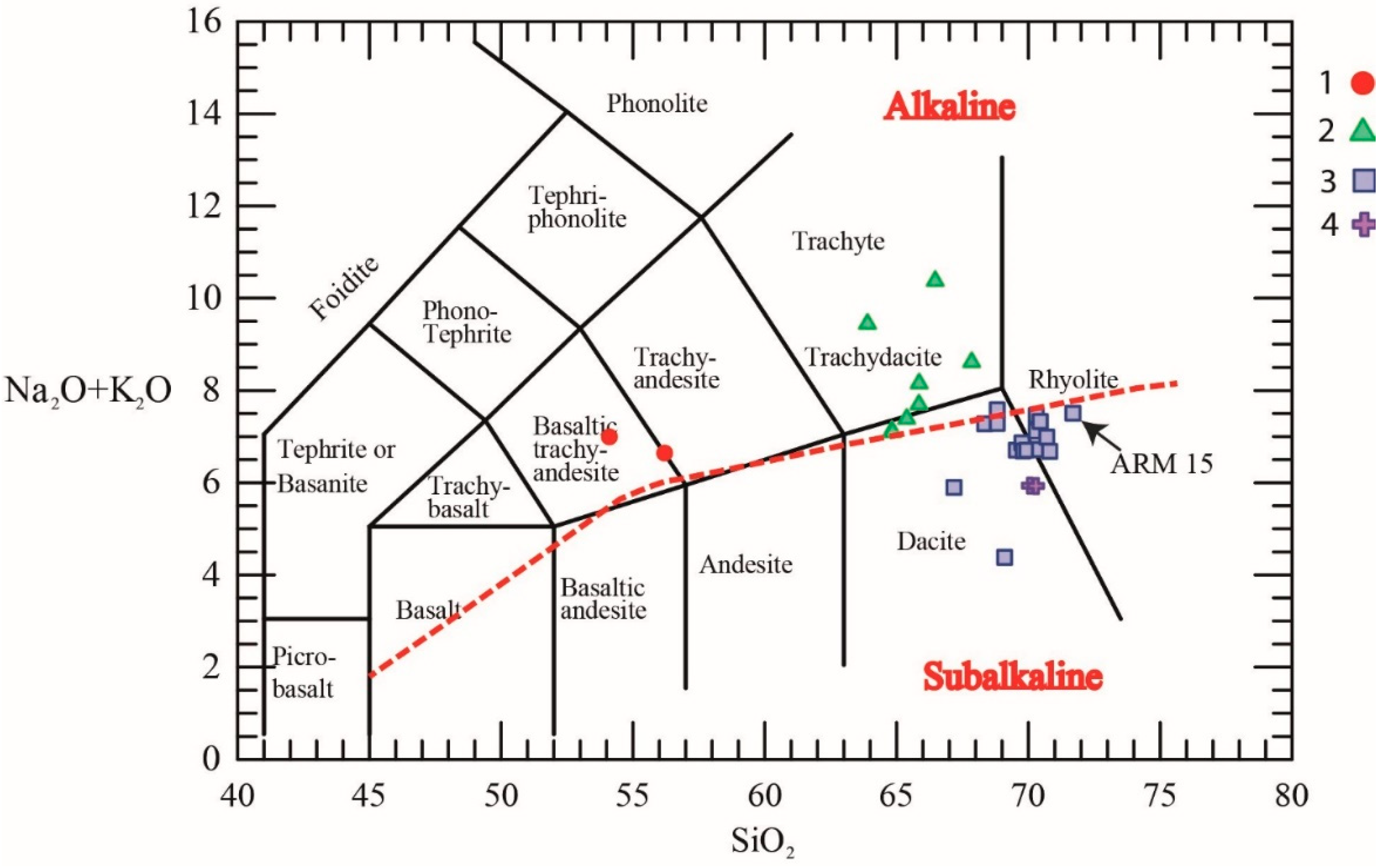
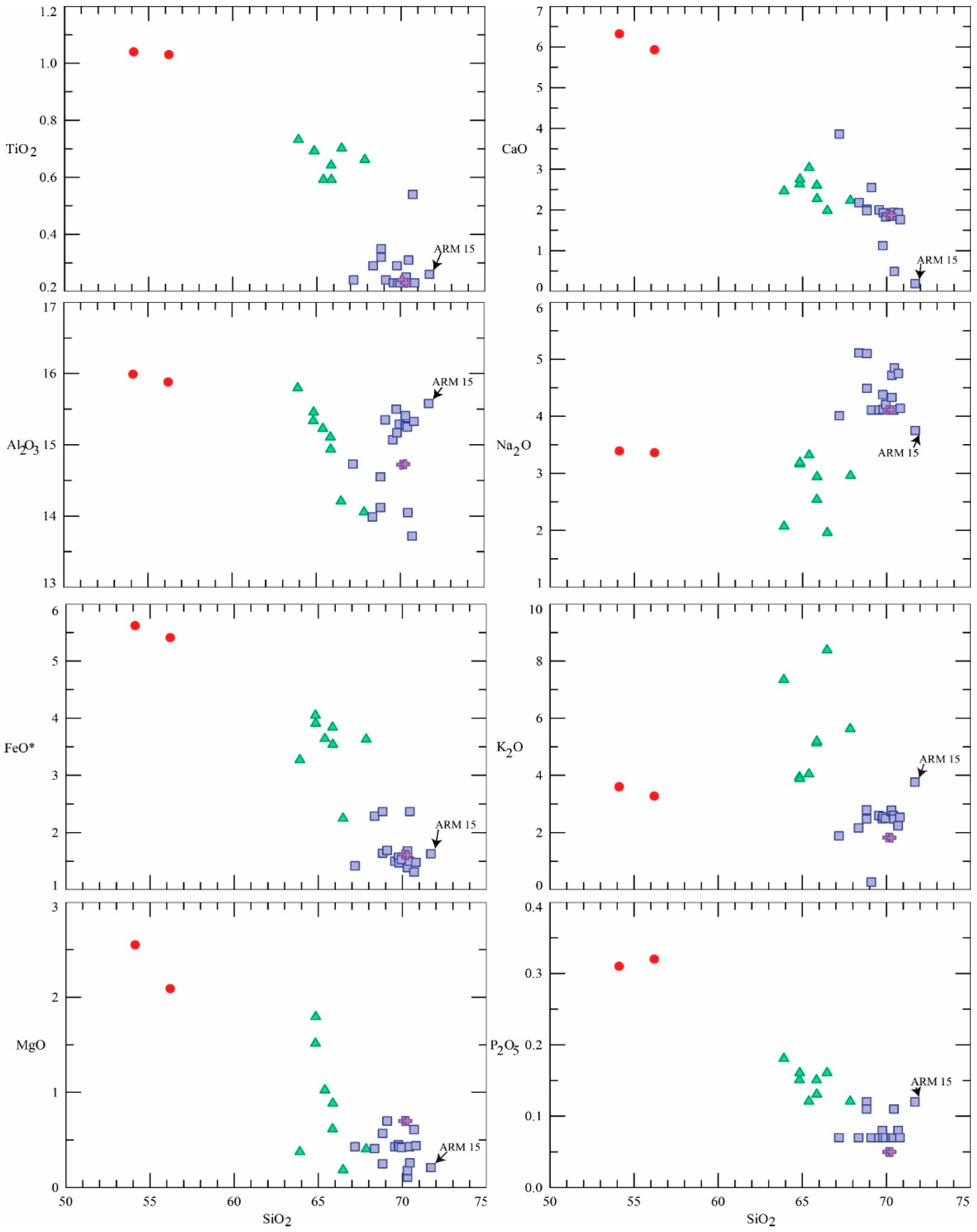
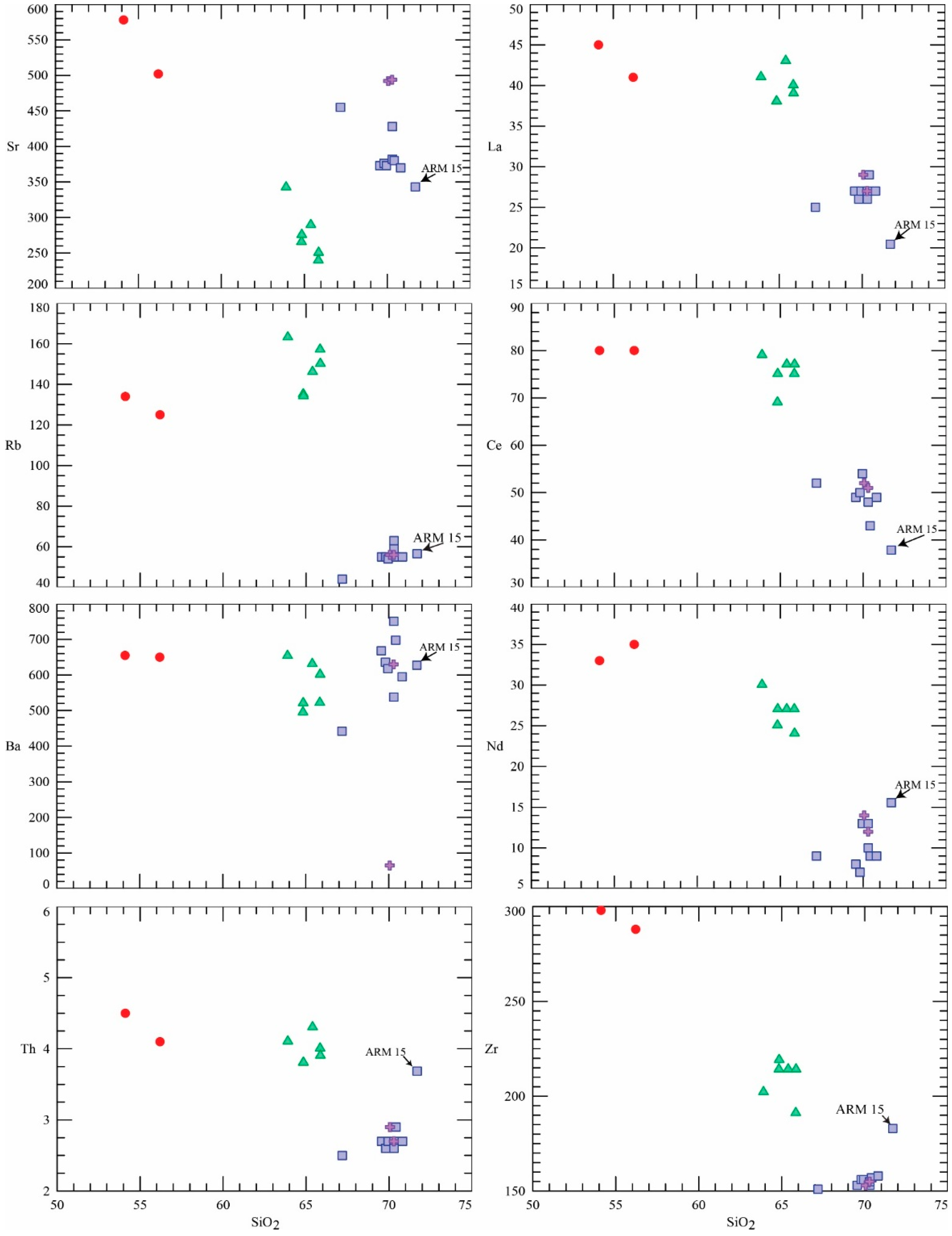
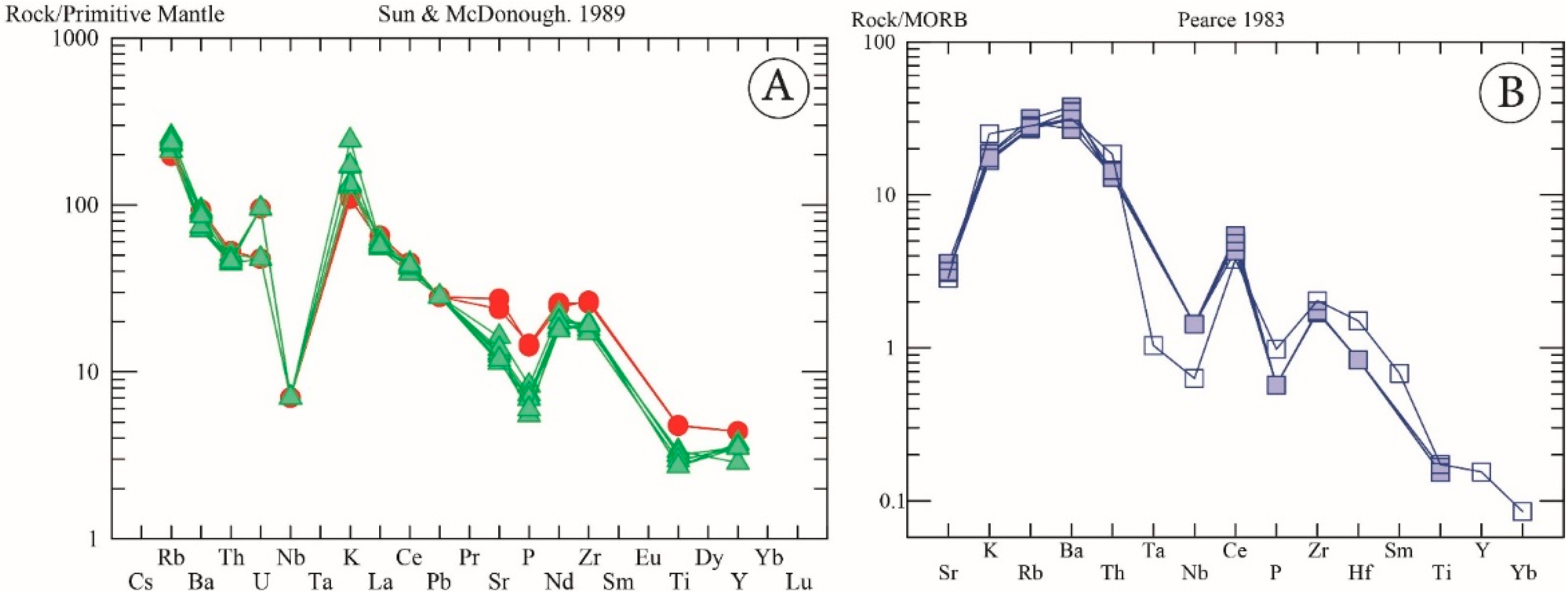
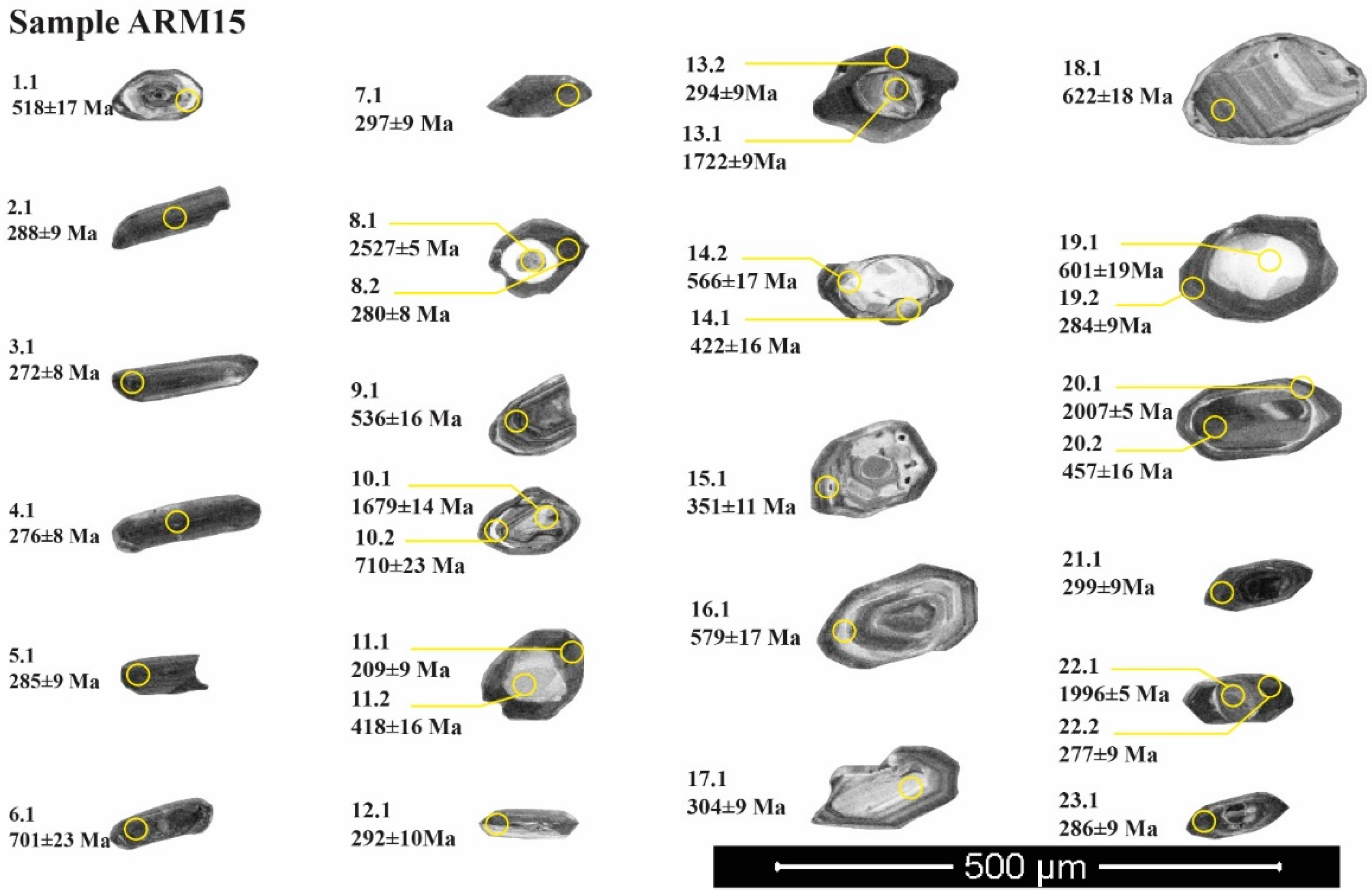

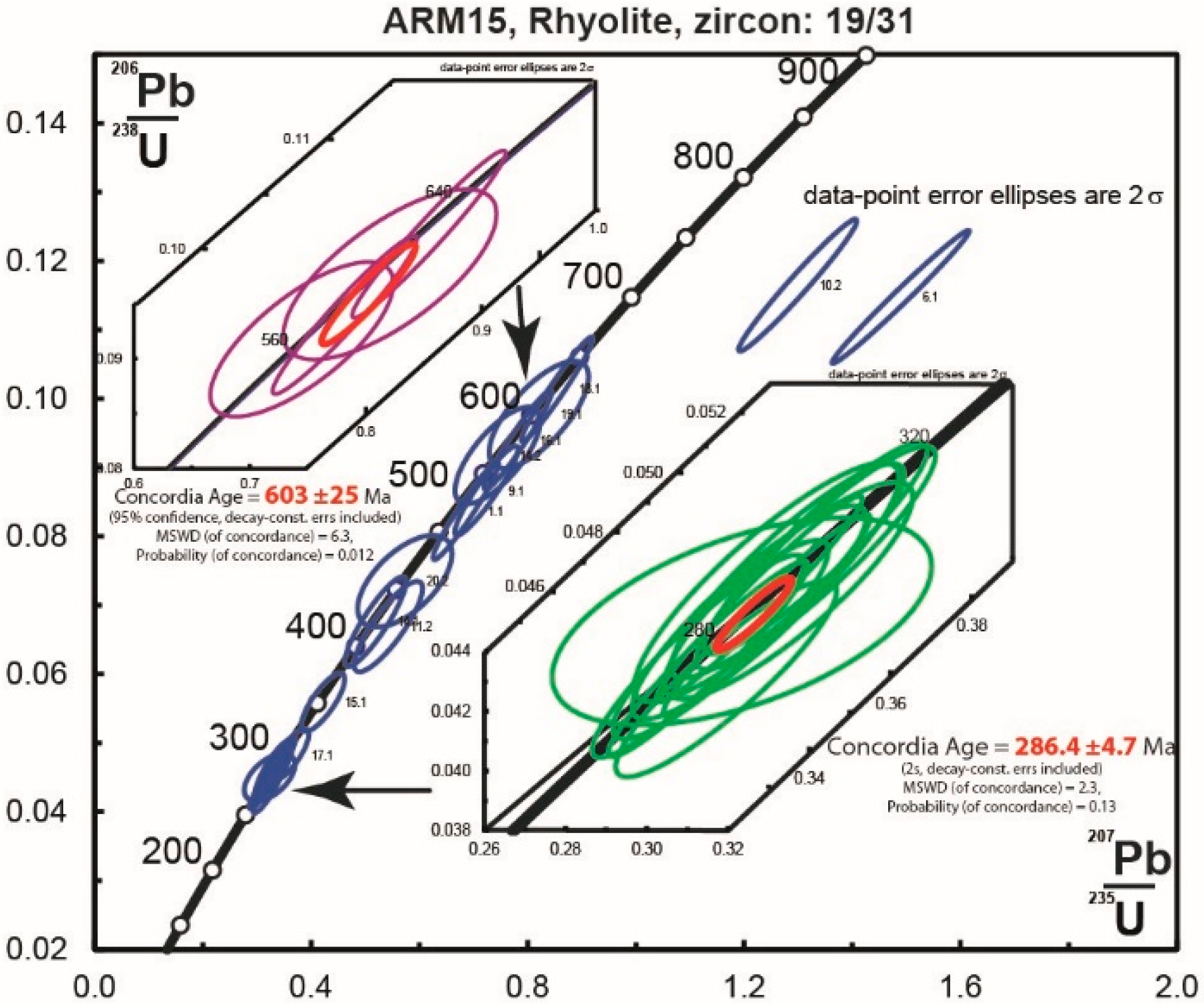


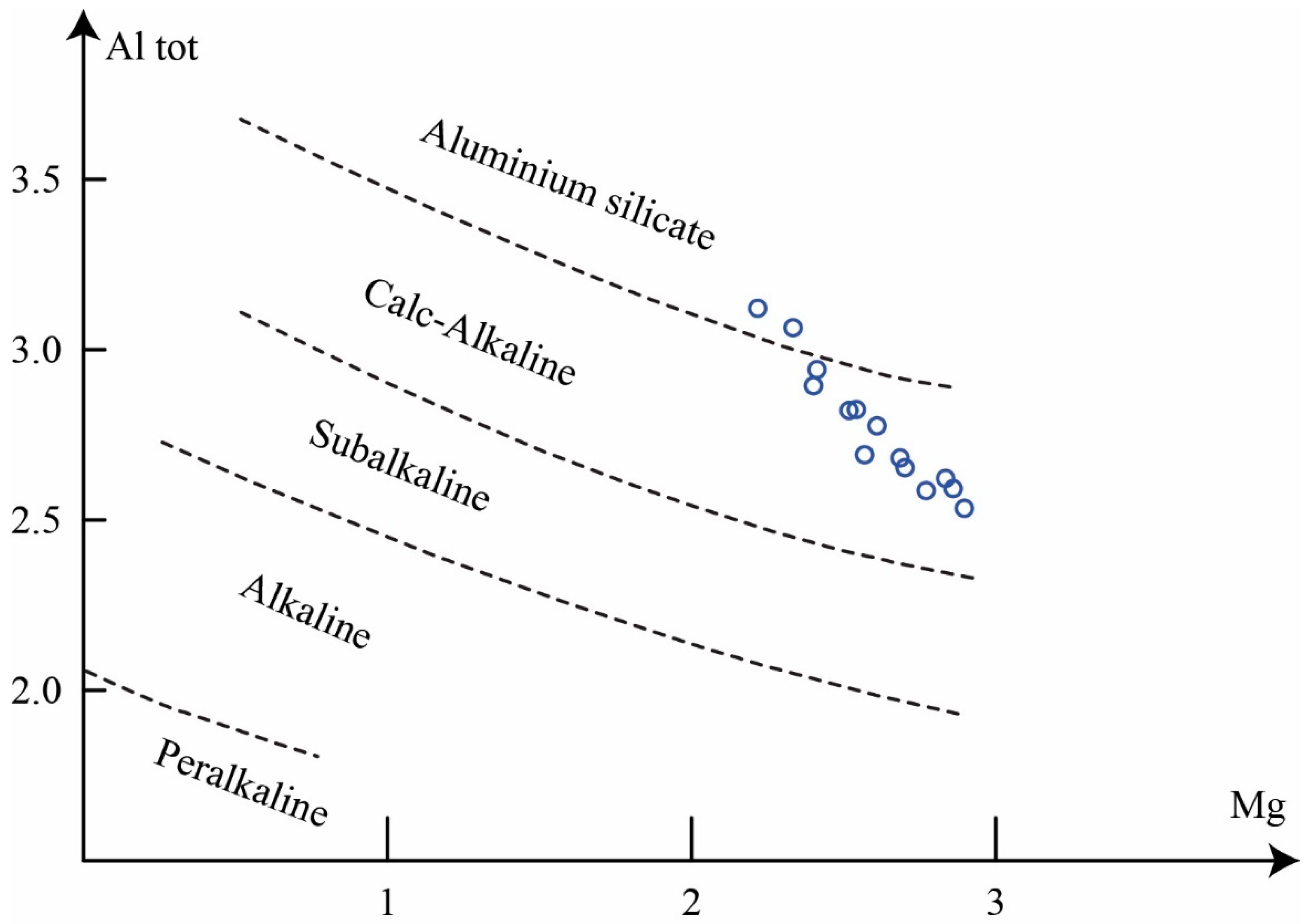
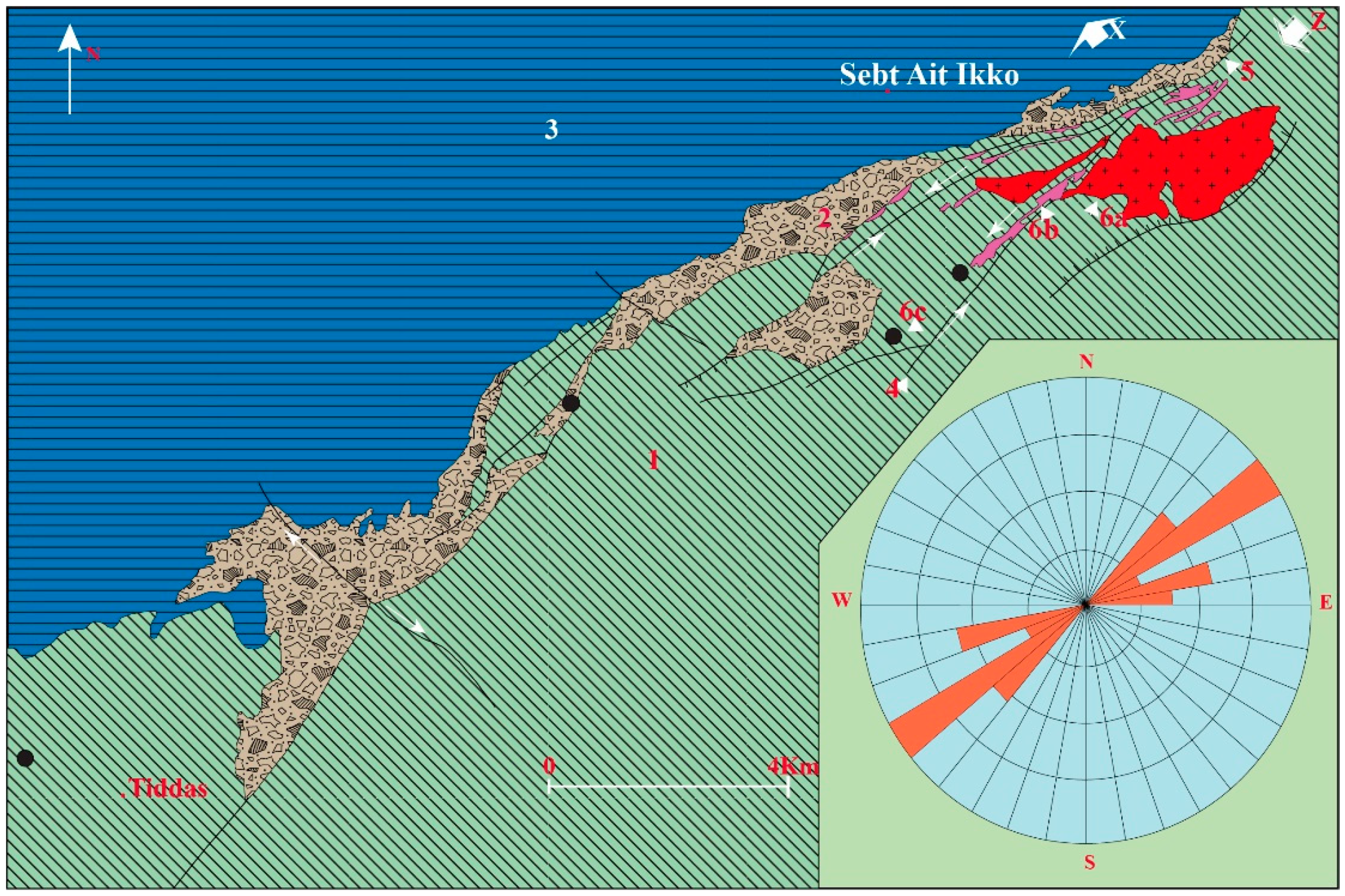
| No Fac. | 1 | 1 | 2 | 2 | 2 | 2 | 2 | 2 | 2 | 2 | 3 | 3 | 3 | 3 |
|---|---|---|---|---|---|---|---|---|---|---|---|---|---|---|
| No Samp. | YK48 | YK49 | YK37 | YK44 | YK43 | YK32 | YK27 | YK1 | W184 * | W186 * | YK6 | W183A * | W181 * | W183B * |
| SiO2 | 54.12 | 56.21 | 63.90 | 64.83 | 64.85 | 65.39 | 65.85 | 65.86 | 66.47 | 67.85 | 67.18 | 68.35 | 68.82 | 68.82 |
| TiO2 | 1.04 | 1.03 | 0.73 | 0.69 | 0.69 | 0.59 | 0.64 | 0.59 | 0.70 | 0.66 | 0.24 | 0.29 | 0.32 | 0.35 |
| Al2O3 | 15.99 | 15.88 | 15.79 | 15.33 | 15.45 | 15.22 | 15.10 | 14.93 | 14.20 | 14.05 | 14.73 | 13.99 | 14.55 | 14.12 |
| Fe2O3t | 5.62 | 5.41 | 3.26 | 4.04 | 3.90 | 3.63 | 3.83 | 3.53 | 2.26 | 3.72 | 1.42 | 2.39 | 2.41 | 1.72 |
| Fe2O3 | - | - | - | - | - | - | - | - | 2.09 | 2.72 | - | 1.44 | 2.04 | 0.96 |
| FeO | - | - | - | - | - | - | - | - | 0.15 | 0.90 | - | 0.85 | 0.33 | 0.68 |
| MnO | 0.06 | 0.07 | 0.01 | 0.05 | 0.04 | 0.02 | 0.04 | 0.02 | 0.02 | 0.03 | 0.02 | 0.03 | 0.06 | 0.01 |
| MgO | 2.55 | 2.09 | 0.37 | 1.51 | 1.79 | 1.02 | 0.61 | 0.88 | 0.18 | 0.4 | 0.43 | 0.41 | 0.25 | 0.57 |
| CaO | 6.32 | 5.93 | 2.45 | 2.62 | 2.74 | 3.02 | 2.59 | 2.26 | 1.97 | 2.22 | 3.86 | 2.18 | 2.02 | 1.98 |
| Na2O | 3.39 | 3.36 | 2.06 | 3.15 | 3.18 | 3.31 | 2.53 | 2.93 | 1.95 | 2.95 | 4.01 | 5.11 | 4.49 | 5.1 |
| K2O | 3.6 | 3.28 | 7.33 | 3.92 | 3.86 | 4.02 | 5.11 | 5.17 | 8.37 | 5.61 | 1.89 | 2.17 | 2.8 | 2.48 |
| P2O5 | 0.31 | 0.32 | 0.18 | 0.15 | 0.16 | 0.12 | 0.15 | 0.13 | 0.16 | 0.12 | 0.07 | 0.07 | 0.12 | 0.11 |
| LOI | 7.1 | 6.13 | 3.07 | 3 | 3.1 | 3.09 | 3.3 | 2.97 | 3.51 | 2.61 | 5.52 | 4.36 | 3.68 | 3.97 |
| Total | 100.1 | 99.71 | 99.15 | 99.29 | 99.76 | 99.43 | 99.75 | 99.27 | 99.77 | 100.12 | 99.37 | 99.25 | 99.48 | 99.15 |
| Rb | 134 | 125 | 163 | 135 | 134 | 146 | 157 | 150 | - | - | 44 | - | - | - |
| Ba | 655 | 650 | 653 | 494 | 520 | 630 | 521 | 600 | - | - | 442 | - | - | - |
| Sr | 578 | 502 | 342 | 265 | 275 | 289 | 239 | 250 | - | - | 455 | - | - | - |
| Th | 4.5 | 4.1 | 4.1 | 3.8 | 3.8 | 4.3 | 4 | 3.9 | - | - | 2.5 | - | - | - |
| U | 1 | 2 | 2 | 2 | 1 | 1 | 2 | 2 | - | - | 2 | - | - | - |
| Pb | 2 | 2 | 2 | 2 | 2 | 2 | 2 | 2 | - | - | 2 | - | - | - |
| Zr | 298 | 288 | 202 | 214 | 219 | 214 | 191 | 214 | - | - | 151 | - | - | - |
| Hf | 4 | 4 | 2 | 3 | 3 | 3 | 1 | 3 | - | - | 2 | - | - | - |
| Nb | 5 | 5 | 5 | 5 | 5 | 5 | 5 | 5 | - | - | 5 | - | - | - |
| La | 45 | 41 | 41 | 38 | 38 | 43 | 40 | 39 | - | - | 25 | - | - | - |
| Ce | 80 | 80 | 79 | 69 | 75 | 77 | 75 | 77 | - | - | 52 | - | - | - |
| Nd | 33 | 35 | 30 | 25 | 27 | 27 | 27 | 24 | - | - | 9 | - | - | - |
| Y | 20 | 20 | 13 | 16 | 16 | 17 | 16 | 16 | - | - | - | - | - | - |
| Cr | 110 | 111 | 37 | 54 | 56 | 52 | 54 | 49 | - | - | 4 | - | - | - |
| Co | 18 | 19 | 9 | 13 | 13 | 9 | 11 | 10 | - | - | - | - | - | - |
| Ni | 41 | 54 | 20 | 25 | 25 | 23 | 32 | 23 | - | - | - | - | - | - |
| V | 110 | 97 | 69 | 65 | 69 | 58 | 53 | 55 | - | - | 7 | - | - | - |
| Cu | 36 | - | - | - | - | - | - | - | - | - | - | - | - | - |
| Zn | 58 | 37 | 28 | 52 | 57 | 45 | 49 | 49 | - | - | 35 | - | - | - |
| Mg # | 0.961 | 0.816 | 0.234 | 0.777 | 0.953 | 0.581 | 0.330 | 0.515 | 0.162 | 0.223 | 0.610 | 0.350 | 0.212 | 0.671 |
| No Fac. | 3 | 3 | 3 | 3 | 3 | 3 | 3 | 3 | 3 | 3 | 3 | 3 | 4 | 4 |
| No Samp. | W147 * | YK4 | W144 * | YK13 | YK19 | YK7 | YK8 | YK5 | W182 * | W145 * | YK12 | ARM15 | YK14F | YK36F |
| SiO2 | 69.1 | 69.55 | 69.76 | 69.8 | 69.95 | 70.3 | 70.3 | 70.42 | 70.45 | 70.7 | 70.81 | 71.69 | 70.06 | 70.29 |
| TiO2 | 0.24 | 0.23 | 0.29 | 0.23 | 0.23 | 0.25 | 0.25 | 0.23 | 0.31 | 0.54 | 0.23 | 0.26 | 0.24 | 0.23 |
| Al2O3 | 15.35 | 15.07 | 15.5 | 15.17 | 15.29 | 15.41 | 15.27 | 15.25 | 14.05 | 13.72 | 15.33 | 15.58 | 14.72 | 14.73 |
| Fe2O3t | 1.73 | 1.5 | 1.63 | 1.47 | 1.53 | 1.68 | 1.39 | 1.5 | 2.40 | 1.44 | 1.48 | - | 1.62 | 1.61 |
| Fe2O3 | 1.36 | - | 1.07 | - | - | - | - | - | 2.08 | 0.18 | - | 1.63 | - | - |
| FeO | 0.33 | - | 0.5 | - | - | - | - | - | 0.29 | 1.13 | - | - | - | - |
| MnO | 0.03 | 0.01 | 0.03 | 0.02 | 0.01 | 0.02 | 0.02 | 0.01 | 0.04 | 0.02 | 0.01 | 0.03 | 0.03 | 0.03 |
| MgO | 0.7 | 0.43 | 0.45 | 0.43 | 0.42 | 0.11 | 0.18 | 0.43 | 0.26 | 0.61 | 0.44 | 0.21 | 0.7 | 0.7 |
| CaO | 2.55 | 2 | 1.12 | 1.93 | 1.83 | 1.85 | 1.92 | 1.94 | 0.49 | 1.93 | 1.76 | 0.19 | 1.88 | 1.87 |
| Na2O | 4.11 | 4.11 | 4.38 | 4.12 | 4.21 | 4.72 | 4.33 | 4.11 | 4.85 | 4.75 | 4.14 | 3.75 | 4.11 | 4.11 |
| K2O | 0.27 | 2.6 | 2.49 | 2.57 | 2.5 | 2.74 | 2.79 | 2.61 | 2.48 | 2.24 | 2.54 | 3.76 | 1.83 | 1.82 |
| P2O5 | 0.07 | 0.07 | 0.08 | 0.07 | 0.07 | 0.07 | 0.07 | 0.07 | 0.11 | 0.08 | 0.07 | 0.12 | 0.05 | 0.05 |
| LOI | 5.51 | 3.45 | 3.6 | 3.31 | 3.2 | 2.69 | 3.1 | 3.34 | 3.33 | 2.91 | 3.22 | 1.98 | 4.15 | 4.07 |
| Total | 99.62 | 99.02 | 99.27 | 99.12 | 99.24 | 99.84 | 99.62 | 99.91 | 98.74 | 98.81 | 100.03 | 99.20 | 99.39 | 99.51 |
| Rb | - | 55 | - | 55 | 54 | 59 | 63 | 55 | - | - | 55 | 56.54 | 56 | 56 |
| Ba | - | 668 | - | 636 | 618 | 538 | 751 | 698 | - | - | 595 | 627.54 | 65 | 630 |
| Sr | - | 373 | - | 376 | 373 | 382 | 428 | 380 | - | - | 370 | 343.00 | 492 | 494 |
| Th | - | 2.7 | - | 2.6 | 2.7 | 2.7 | 2.6 | 2.9 | - | - | 2.7 | 3.69 | 2.9 | 2.7 |
| U | - | 2 | - | 2 | 2 | 2 | 2 | 2 | - | - | 2 | 0.63 | 2 | 2 |
| Pb | - | 2 | - | 2 | 2 | 2 | 2 | 2 | - | - | 2 | 30.93 | 2 | 2 |
| Zr | - | 153 | - | 156 | 156 | 153 | 155 | 157 | - | - | 158 | 183.00 | 153 | 155 |
| Hf | - | 2 | - | 2 | 2 | 2 | 2 | 2 | - | - | 2 | 3.60 | 2 | 2 |
| Nb | - | 5 | - | 5 | 5 | 5 | 5 | 5 | - | - | 5 | 2.21 | 5 | 5 |
| La | - | 27 | - | 26 | 27 | 27 | 26 | 29 | - | - | 27 | 20.45 | 29 | 27 |
| Ce | - | 49 | - | 50 | 54 | 48 | 48 | 43 | - | - | 49 | 37.85 | 52 | 51 |
| Nd | - | 8 | - | 7 | 13 | 13 | 10 | 9 | - | - | 9 | 15.58 | 14 | 12 |
| Y | - | - | - | - | - | - | - | - | - | - | - | 4.64 | - | - |
| Cr | - | 2 | - | 1 | 1 | 3 | 2 | 10 | - | - | 3 | - | 1 | - |
| Co | - | - | - | - | - | - | - | - | - | - | - | - | - | - |
| Ni | - | - | - | - | - | - | - | - | - | - | - | 23.00 | - | - |
| V | - | 9 | - | 11 | 9 | 14 | 12 | 12 | - | - | 11 | - | 9 | 11 |
| Cu | - | - | - | - | - | - | - | - | - | - | - | - | - | - |
| Zn | - | 15 | - | 13 | 13 | 38 | 98 | 14 | - | - | 16 | - | 76 | 76 |
| Mg # | 0.819 | 0.578 | 0.559 | 0.589 | 0.554 | 0.132 | 0.261 | 0.578 | 0.221 | 0.855 | 0.599 | - | 0.872 | 0.878 |
| Unit/ Sample | Spot Name | Concentrations | Ratios | Ages (Ma) | Conc % | ||||||||||||||||
|---|---|---|---|---|---|---|---|---|---|---|---|---|---|---|---|---|---|---|---|---|---|
| U (ppm) | Th (ppm) | 232Th 238U | ± % | 206Pb* (ppm) | 206Pbc (%) | 238U 206Pb* | 1 σ % | 207Pb* 206Pb* | 1 σ % | 207Pb* 235U | 1 σ % | 206Pb* 238U | 1 σ % | Rho | 206Pb 238U | 1 σ (Ma) | 207Pb 206Pb | 1 σ (Ma) | |||
| Tiddas Souk Es-Sebt Des Ait Ikko/Ari el Mahsar/ARM15 | 1.1 | 283 | 171 | 0.62 | 2.31 | 20.3 | 0.30 | 11.945 | 3.468 | 0.0594 | 0.991 | 0.69 | 3.607 | 0.084 | 3.468 | 0.962 | 518 | 17 | 582 | 22 | 111 |
| 2.1 | 615 | 365 | 0.61 | 1.59 | 24.2 | −0.02 | 21.851 | 3.083 | 0.0519 | 0.721 | 0.33 | 3.166 | 0.046 | 3.083 | 0.974 | 288 | 9 | 282 | 16 | 98 | |
| 3.1 | 632 | 468 | 0.76 | 0.78 | 23.4 | 0.56 | 23.206 | 3.121 | 0.0538 | 1.527 | 0.32 | 3.474 | 0.043 | 3.121 | 0.898 | 272 | 8 | 362 | 34 | 125 | |
| 4.1 | 675 | 383 | 0.59 | 1.34 | 25.3 | 0.15 | 22.856 | 3.055 | 0.0522 | 0.904 | 0.32 | 3.186 | 0.044 | 3.055 | 0.959 | 276 | 8 | 295 | 21 | 107 | |
| 5.1 | 619 | 260 | 0.43 | 4.79 | 24.0 | 0.14 | 22.116 | 3.053 | 0.0529 | 0.807 | 0.33 | 3.158 | 0.045 | 3.053 | 0.967 | 285 | 9 | 323 | 18 | 112 | |
| 6.1 | 497 | 219 | 0.46 | 0.69 | 47.1 | 4.08 | 8.711 | 3.447 | 0.0941 | 0.508 | 1.49 | 3.484 | 0.115 | 3.447 | 0.989 | 701 | 23 | 1510 | 10 | 157 | |
| 7.1 | 399 | 169 | 0.44 | 0.22 | 16.1 | 0.16 | 21.211 | 3.237 | 0.0525 | 1.400 | 0.34 | 3.527 | 0.047 | 3.237 | 0.918 | 297 | 9 | 309 | 32 | 104 | |
| 8.1 | 165 | 97 | 0.60 | 0.66 | 64.5 | 1.21 | 2.174 | 3.087 | 0.1669 | 0.285 | 10.59 | 3.101 | 0.460 | 3.087 | 0.996 | 2439 | 63 | 2527 | 5 | 104 | |
| 8.2 | 669 | 380 | 0.59 | 0.22 | 25.5 | 0.23 | 22.522 | 3.063 | 0.0520 | 1.496 | 0.32 | 3.409 | 0.044 | 3.063 | 0.899 | 280 | 8 | 284 | 34 | 101 | |
| 9.1 | 564 | 744 | 1.36 | 0.49 | 41.8 | 0.80 | 11.541 | 3.057 | 0.0606 | 1.227 | 0.72 | 3.294 | 0.087 | 3.057 | 0.928 | 536 | 16 | 625 | 26 | 115 | |
| 10.1 | 229 | 50 | 0.23 | 1.47 | 49.8 | 1.37 | 3.902 | 3.165 | 0.1030 | 0.784 | 3.64 | 3.260 | 0.256 | 3.165 | 0.971 | 1471 | 42 | 1679 | 14 | 114 | |
| 10.2 | 484 | 160 | 0.34 | 2.51 | 47.3 | 2.26 | 8.583 | 3.371 | 0.0809 | 0.722 | 1.30 | 3.448 | 0.117 | 3.371 | 0.978 | 710 | 23 | 1219 | 14 | 144 | |
| 11.1 | 557 | 323 | 0.60 | 0.71 | 22.0 | 0.56 | 3.223 | 0.0527 | 1.871 | 0.33 | 3.727 | 0.046 | 3.223 | 0.865 | 290 | 9 | 318 | 43 | 109 | ||
| 11.2 | 176 | 86 | 0.50 | 9.59 | 10.1 | 0.31 | 14.943 | 4.013 | 0.0588 | 2.546 | 0.54 | 4.753 | 0.067 | 4.013 | 0.844 | 418 | 16 | 561 | 55 | 126 | |
| 12.1 | 582 | 387 | 0.69 | 0.83 | 23.2 | 0.35 | 21.585 | 3.531 | 0.0516 | 1.963 | 0.33 | 4.039 | 0.046 | 3.531 | 0.874 | 292 | 10 | 267 | 45 | 90 | |
| 13.1 | 195 | 81 | 0.43 | 0.65 | 39.9 | 2.04 | 4.114 | 3.089 | 0.1055 | 0.495 | 3.53 | 3.129 | 0.243 | 3.089 | 0.987 | 1403 | 39 | 1722 | 9 | 121 | |
| 13.2 | 652 | 332 | 0.53 | 0.73 | 26.2 | 0.18 | 21.409 | 3.143 | 0.0520 | 1.543 | 0.33 | 3.501 | 0.047 | 3.143 | 0.898 | 294 | 9 | 284 | 35 | 96 | |
| 14.1 | 497 | 171 | 0.36 | 0.41 | 28.9 | 0.14 | 14.786 | 3.937 | 0.0556 | 2.050 | 0.52 | 4.439 | 0.068 | 3.937 | 0.887 | 422 | 16 | 438 | 46 | 104 | |
| 14.2 | 105 | 56 | 0.55 | 0.39 | 8.3 | 0.55 | 10.896 | 3.138 | 0.0589 | 2.984 | 0.74 | 4.330 | 0.092 | 3.138 | 0.725 | 566 | 17 | 562 | 65 | 99 | |
| 15.1 | 243 | 116 | 0.49 | 0.29 | 11.7 | 0.54 | 17.881 | 3.087 | 0.0548 | 2.342 | 0.42 | 3.875 | 0.056 | 3.087 | 0.797 | 351 | 11 | 402 | 52 | 113 | |
| 16.1 | 300 | 139 | 0.48 | 0.27 | 24.2 | 0.07 | 10.638 | 3.133 | 0.0603 | 0.876 | 0.78 | 3.254 | 0.094 | 3.133 | 0.963 | 579 | 17 | 616 | 19 | 106 | |
| 17.1 | 471 | 186 | 0.41 | 0.81 | 19.5 | 0.58 | 20.707 | 3.190 | 0.0541 | 2.456 | 0.36 | 4.026 | 0.048 | 3.190 | 0.792 | 304 | 9 | 376 | 55 | 120 | |
| 18.1 | 336 | 104 | 0.32 | 0.55 | 29.2 | 0.09 | 9.864 | 3.072 | 0.0611 | 0.754 | 0.85 | 3.163 | 0.101 | 3.072 | 0.971 | 622 | 18 | 644 | 16 | 104 | |
| 19.1 | 49 | 52 | 1.10 | 0.46 | 4.1 | 0.39 | 10.235 | 3.248 | 0.0609 | 3.219 | 0.82 | 4.573 | 0.098 | 3.248 | 0.710 | 601 | 19 | 637 | 69 | 106 | |
| 19.2 | 440 | 186 | 0.44 | 2.01 | 17.0 | 0.87 | 22.216 | 3.150 | 0.0521 | 4.986 | 0.32 | 5.897 | 0.045 | 3.150 | 0.534 | 284 | 9 | 290 | 114 | 102 | |
| 20.1 | 361 | 4 | 0.01 | 1.34 | 101.3 | 1.44 | 3.023 | 3.071 | 0.1235 | 0.307 | 5.63 | 3.086 | 0.331 | 3.071 | 0.995 | 1842 | 49 | 2007 | 5 | 125 | |
| 20.2 | 1129 | 410 | 0.37 | 0.35 | 71.3 | 1.01 | 13.605 | 3.706 | 0.0566 | 4.970 | 0.57 | 6.199 | 0.074 | 3.706 | 0.598 | 457 | 16 | 475 | 110 | 104 | |
| 21.1 | 774 | 478 | 0.64 | 0.19 | 31.6 | 0.14 | 21.065 | 3.058 | 0.0522 | 1.213 | 0.34 | 3.290 | 0.047 | 3.058 | 0.930 | 299 | 9 | 294 | 28 | 98 | |
| 22.1 | 461 | 45 | 0.10 | 2.34 | 112.5 | 2.73 | 3.424 | 3.063 | 0.1227 | 0.274 | 4.94 | 3.075 | 0.292 | 3.063 | 0.996 | 1652 | 45 | 1996 | 5 | 120 | |
| 22.2 | 1082 | 920 | 0.88 | 0.19 | 40.7 | 0.14 | 22.807 | 3.162 | 0.0517 | 1.283 | 0.31 | 3.413 | 0.044 | 3.162 | 0.927 | 277 | 9 | 273 | 29 | 99 | |
| 23.1 | 649 | 399 | 0.63 | 0.46 | 25.3 | 0.30 | 22.068 | 3.223 | 0.0520 | 1.643 | 0.33 | 3.618 | 0.045 | 3.223 | 0.891 | 286 | 9 | 287 | 38 | 101 | |
Publisher’s Note: MDPI stays neutral with regard to jurisdictional claims in published maps and institutional affiliations. |
© 2021 by the authors. Licensee MDPI, Basel, Switzerland. This article is an open access article distributed under the terms and conditions of the Creative Commons Attribution (CC BY) license (https://creativecommons.org/licenses/by/4.0/).
Share and Cite
Hadimi, I.; Youbi, N.; Ait Lahna, A.; Bensalah, M.K.; Moutbir, O.; Mata, J.; Doblas, M.; Tassinari, C.C.G.; Gaggero, L.; Basei, M.A.S.; et al. U–Pb Zircon Geochronological and Petrologic Constraints on the Post-Collisional Variscan Volcanism of the Tiddas-Souk Es-Sebt des Aït Ikko Basin (Western Meseta, Morocco). Minerals 2021, 11, 1099. https://doi.org/10.3390/min11101099
Hadimi I, Youbi N, Ait Lahna A, Bensalah MK, Moutbir O, Mata J, Doblas M, Tassinari CCG, Gaggero L, Basei MAS, et al. U–Pb Zircon Geochronological and Petrologic Constraints on the Post-Collisional Variscan Volcanism of the Tiddas-Souk Es-Sebt des Aït Ikko Basin (Western Meseta, Morocco). Minerals. 2021; 11(10):1099. https://doi.org/10.3390/min11101099
Chicago/Turabian StyleHadimi, Ismail, Nasrrddine Youbi, Abdelhak Ait Lahna, Mohamed Khalil Bensalah, Oussama Moutbir, João Mata, Miguel Doblas, Colombo Celso Gaeta Tassinari, Laura Gaggero, Miguel Angelo Stipp Basei, and et al. 2021. "U–Pb Zircon Geochronological and Petrologic Constraints on the Post-Collisional Variscan Volcanism of the Tiddas-Souk Es-Sebt des Aït Ikko Basin (Western Meseta, Morocco)" Minerals 11, no. 10: 1099. https://doi.org/10.3390/min11101099
APA StyleHadimi, I., Youbi, N., Ait Lahna, A., Bensalah, M. K., Moutbir, O., Mata, J., Doblas, M., Tassinari, C. C. G., Gaggero, L., Basei, M. A. S., Sato, K., El Moume, W., & Boumehdi, M. A. (2021). U–Pb Zircon Geochronological and Petrologic Constraints on the Post-Collisional Variscan Volcanism of the Tiddas-Souk Es-Sebt des Aït Ikko Basin (Western Meseta, Morocco). Minerals, 11(10), 1099. https://doi.org/10.3390/min11101099










